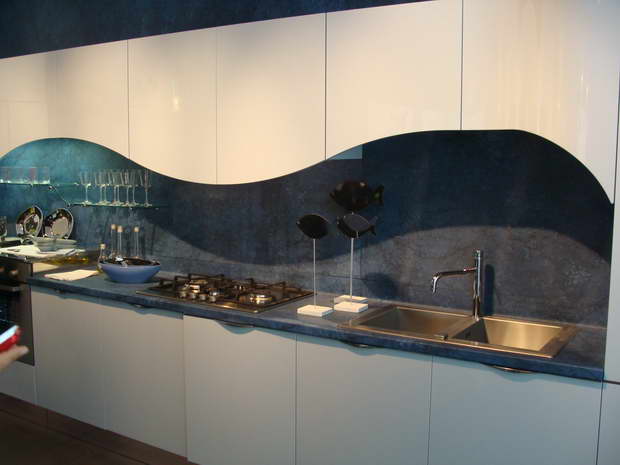Kitchen can not be sterile; ultimately this is not the goal, but pay attention to those places in the kitchen where causes of numerous diseases can develop
Different bacteria, viruses, microorganisms, fungi and mold are a part of our everyday life. They are on us, inside us and all around us. None of us lives in sterile conditions, and even if it was possible it would not be healthy. In fact, our body must develop immunity to harmful organisms that surround us from the birth, and one way is with proper nutrition and hygiene, but not sterile conditions. Therefore, we will not die if we occasionally eat a cookie that we dropped on the floor or if we slice bread on a surface that is not perfectly clean or with a perfectly clean knife.
Examples can go on for ever. However, there are certain places in the kitchen that can be little nurseries for very dangerous microorganism, which can be very hazardous to your health, especially for children who have not yet acquired the necessary immunity.
Think, when was the last time you paid attention to cleaning of surfaces which you often touch with your wet hands, or with hands you just used to prepare food.
Refrigerator handle
Microbes that live in meat and other foods almost always can be found on the refrigerator door handle, because when preparing certain types of foods, we often reach for the refrigerator without washing our hands. The same goes for all the handles in the kitchen, at least according to the experience with the most exposed ones, on the refrigerator door and places where we keep foodstuffs. We repeatedly go back to the same place and touch it, without even thinking that there are already bacteria from the previous days and weeks. We do not believe that anyone cleans these places on a daily, weekly, or even monthly basis, unless they are visibly dirty.
The easiest way to prevent such a spread of germs back onto your hands, food and other kitchen appliances is to wash your hands with ordinary soap and rub for 15 seconds in warm water and close the tap without touching it – close it with an elbow, or if you just must use the fingers, do it over a paper towel. Of course, do not forget to regularly disinfect the mentioned “critical” places in the kitchen.
Kitchen towels
We just can’t live without them. They are almost constantly in our hands when we are in the kitchen, because we use them to dry our hands, kitchen surfaces, dishes, for holding hot pots, and it is quite incredible that we all consider them to be clean if we do not see any visible signs of contamination… In fact, kitchen towels are one of the largest nurseries of various bacteria and germs. When you use them for wiping clean dishes and clean hands, because of the moisture that stays on them and the heat that is present in the kitchen, bacteria can easily begin to multiply on them. Remember, just because something is clean it does not mean it’s sterile, this goes for your hands, utensils and kitchen surfaces.
The easiest way to prevent the spread of germs all over the kitchen is to change kitchen towels every day, and when you wash them, let it be to at least 60°, preferably 90° Celsius. So for everyday use acquire the ordinary cotton kitchen towels, which can be washed at such high temperatures.
Kitchen sponge
Just because the sponge looks clean, it does not mean it is clean. On the contrary, sponge is one of the dirtiest items in the kitchen.
One of the biggest mistakes that people make when it comes to the use of kitchen sponges is to scrub the sink with it, and then to use the same sponge to wipe the kitchen worktops. Sink is ultimately the dirtiest place in the kitchen, because of the water and everything that we soak and wash in it. From the sink, bacteria can easily be carried over to a sponge and from a sponge to the kitchen worktop – the most common bacteria are E. coli and salmonella.
In order to prevent the spread of bacteria, besides avoiding the above mentioned actions, regularly change the kitchen sponges or cook them in hot water with detergent, which will kill all the germs. Also, each time after using the sponge, drain it well and leave it to dry on the edge of the sink. Water is a perfect place for the development of various bacteria, microorganisms and accumulation of various dirt and grease.
Kitchen sink
We have arrived to the last great nursery of bacteria and fungi, and it is the kitchen sink, i.e. the drain of the sink. In general, most of us are governed by the rule: what you do not see does not exist. But, drains are the very places in which the most dangerous bacteria and other microorganisms accumulate, as well as different types of fungi and mold which can easily be spread from the drain into the sink. Besides that, the sink itself is, due to washing and rinsing that takes place in it, exposed to the constant development of microorganisms which feed on food and water residue.
One ways to prevent the spread of any infection and germs, and the development of unwanted “guests” in drains, is to boil water once a week in the biggest pot you have and pour it down the drain. Hot water will kill many harmful microorganisms. Also, pour hydrochloric acid in the sink overnight, and in the morning rinse it with hot water. Be careful when handling hydrochloric acid.
